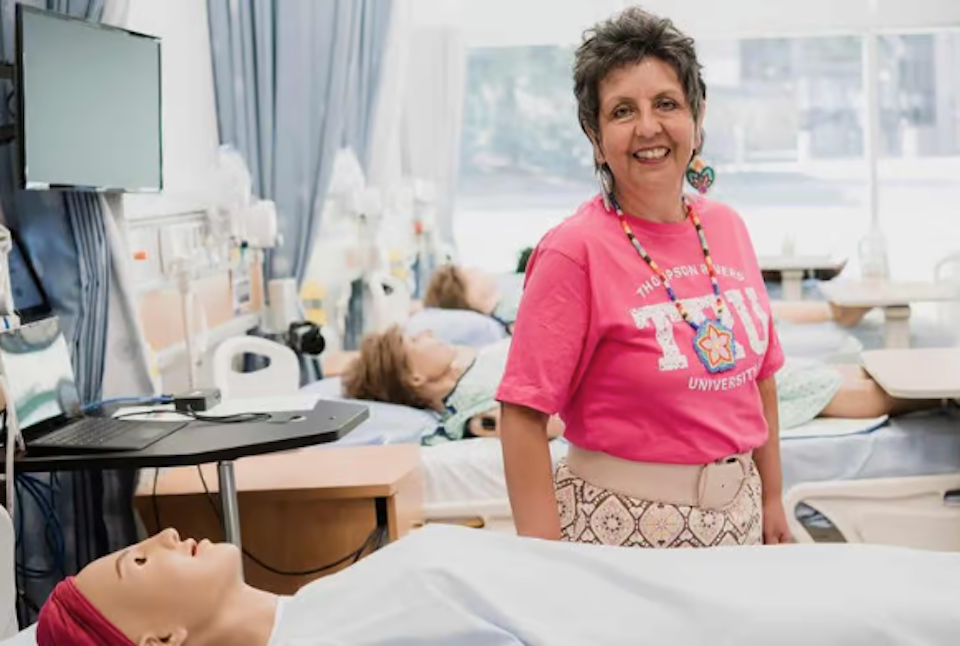Six universities across “С����Ƶ” have partnered to embark on a research project that would bring a master’s of Indigenous nursing program to life, an initiative that is designed to address racism in the health-care industry, better support Indigenous health-care providers and meet the unique needs of communities by incorporating Indigenous knowledge into mainstream practice.
“Reclaiming and Recovering Indigenous Knowledge in Graduate Nursing Education” is a collaborative effort between six schools of nursing: Thompson Rivers University, University of Victoria, Trinity Western University, University of Northern British Columbia and University of British Columbia Vancouver and Okanagan.
The schools jointly received $683,000 from the Canadian Institutes of Health Research (CIHR) to develop and launch the project.
In September, delegates from each school gathered in snpintktn (Penticton) in syilx homelands to determine a roadmap for how they will individually contribute to the research. Joining them online were dozens of Indigenous nurses and nurse educators, Elders, Knowledge Keepers and leaders.
Leading the project is Lisa Bourque Bearskin, a Métis and nehiyaw iskwêw (Cree woman) from Beaver Lake Cree Nation. Bearskin is a registered nurse leader who holds an Indigenous health research chair in nursing with CIHR, and previously served as the president of the Canadian Indigenous Nursing Association.
Her hope is that the master’s program will eventually train and empower roughly 30 Indigenous nurses with a higher level of expertise to work with their communities and within their own knowledge systems.
Equipping nurses with relational practices and having them adopt a holistic approach to health — one that incorporates the land and its medicines to aid with spiritual, mental and physical wellness — will be a major focal point of the program, she said.
“It’s that uniqueness that Indigenous nurses have, coming from that place of Indigeneity, to know that we are related to that rock.”
Incorporating an Indigenous lens that embraces the interconnected web of all living things “really needs to happen” in the healthcare system, she said.
“[This includes] how we are connected to the land, the people, our culture and language.”
She added that the schools are now working to strengthen relationships with the respective Indigenous communities where their institutions are located.
“We really need to create a place where communities see themselves in this,” said Bearskin, who’s an associate professor in nursing at the University of Victoria.
“That service back to the community is essential to the program. It’s a buy-in for them.”
She noted that, historically, schools of nursing have not had good relationships with Indigenous communities. So it’s the communities, Bearskin said, who are the ones helping to co-design the project’s collaborative framework.
“Establishing how we’ll work together, how we’ll distribute the resources, who our responsibility is to, relearn history, to leverage the Indigenous voice and to do the work in a good way where we’re aligning our approach to sovereignty and self-determination,” she said.
In her 40-year career in nursing, Bearskin said that the industry is currently in a crisis due to a shortage of health-care providers. But she said that while there are Indigenous nurses who want to get into nursing, they ultimately choose not to “because the system is designed to be racist.”
“It’s not a safe place to learn, so there’s a reluctance to come into nursing and there’s a fast exit of leaving nursing,” she said. “We can’t just keep recruiting nurses into nursing if we don’t change the system.”
According to survey results from the In Plain Sight report released in 2020, which examined racism and discrimination against Indigenous peoples in the С����Ƶ health-care system, 59 per cent of Indigenous health care workers said that their colleagues expressed discriminatory or hateful comments in front of them.
“Listening to all these stories around racism, I think about the fatigue that we hold as Indigenous nurses,” said Bearskin. “We embody this harm when we go with our patients.”
More than 90 per cent of respondents said that the racial prejudice they experienced in the workplace impacted both their mental and emotional health.
“There is insufficient effort to recruit, train and retain Indigenous health-care professionals,” states the report, noting that very few degree programs exist that maintain or successfully meet targets for Indigenous enrollment.
“What is clear from the Indigenous students and health-care workers who contributed to this review is that racism exists in the learning environment, poses challenges to successful completion of their studies, and has negative personal impacts.”
One of the report’s recommendations is that the provincial government work with Indigenous nurses, experts and educational institutions to create a joint degree program for nursing professions.
Similarly, the 23rd call to action in the Truth and Reconciliation Commission’s (TRC) 94 calls to action asks that all levels of government increase the number of Indigenous professionals working in the health-care field; ensure the retention of Indigenous health-care providers in Indigenous communities; and provide cultural competency training for all health-care professionals.
While training Indigenous nurses is the priority, Bearskin said that the master’s of Indigenous nursing program in development would welcome non-Indigenous health-care providers who show a willingness to work and build relationships with Indigenous communities.
“It’s not exclusive, but again, privileging the needs of the community and the nurses that serve that community,” she said.
Ideally, Bearskin said that she’d like to see the first cohort of the program up and running in September 2023. But depending on the availability of faculty and resources at each school, the program may not launch until 2025.
Once the program does take off, she said that it will offer a valuable perspective to nursing academia. More importantly, she said it will create a specialty in training nurses to work in First Nations, Métis and Inuit communities.
“It will definitely open up some of those alternate pathways to think, ‘Hey, there is more than one way to nurse,’” she said.



